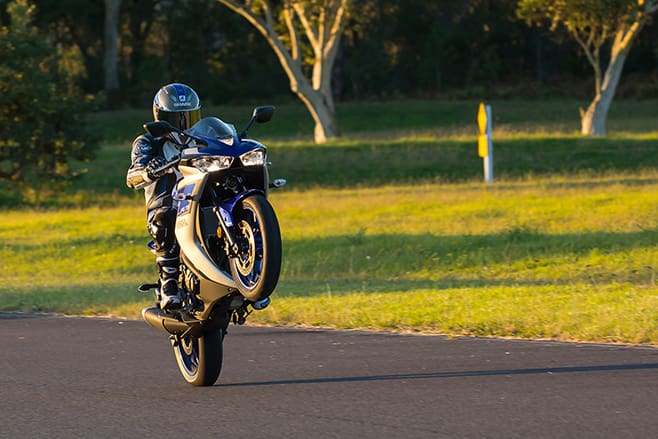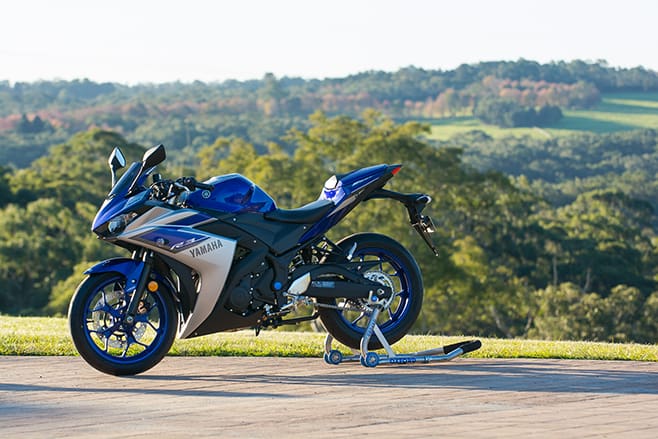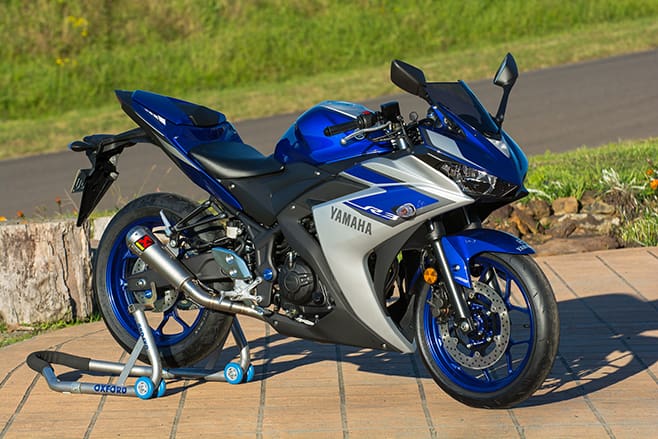The YZF-R3 has borrowed some of the technology from its bigger R6 and R1 siblings to help create a perfect combination between rideability and excitement.
When Yamaha introduced the R1 back in 1991 they described it as being the true value of ‘Kando’, Yamaha’s corporate philosophy. Loosely translated: “the simultaneous feelings of deep satisfaction and intense excitement that you experience when you encounter something of exceptional value”.
That’s one way to describe the YZF-R3 but I’d describe it as wow.

Not because of blistering speed or technological wizardry like its bigger sibling, but because that’s the sense you get riding this sublime pint-sized package. Wow because at 10,500 revs it still wants to pull, wow because when you tip into a tight corner you realise how eager it is to turn, and wow because it leaves you with a grin from ear-to-ear, and I reckon it would leave even the most seasoned riders amongst us with a wiry old smile of some sort.
Yamaha describe the R3 as a ‘Supersport machine you can ride every day’. Ok, so they may have embellished on the supersport part a bit but the new powerplant is far from boring. At one end it’s practical and provides good rideability in the low to mid-range power, then shows a bit of the R-series character at higher rpm making it both practical and exciting to ride.
It’s all new 321cc inline twin has 25cc more than the Ninja 300 (296cc) and an extra five ponies (42hp compared to 37hp). The new engine has also borrowed some of the technology from its bigger R6 and R1 siblings such as lightweight forged aluminium pistons which are 10% lighter, and also stronger than cast pistons, resulting in better reliability at higher rpms. It’s also the first twin-cylinder Yamaha to use a lightweight DiaSil cylinder (see breakout), which helps with heat dissipation to reduce the loss of horsepower.

The moment I threw my leg over it I could tell it was designed with ease of use in mind. Unlike a true supersport the seating position on the R3 is relaxed with the clip-ons placed above the triple clamp. It’s got a seat height of 780mm which narrows at the front to make it more accessible to those of shorter stature who like to get a foot or two firmly planted on the ground.
The R3’s instrument panel has an analogue tachometer and digital speedometer and it’s packed with easy to read info such as a fuel gauge, gear position indicator, clock, water temp, trip meters, fuel economy and more, and it even has a shift light similar to the YZF-R1 in design.
Weighing only 169kg and with a front/rear weight balance of almost 50/50 it handles slow speed manoeuvres with ease and predictability.

Taking off from Yamaha HQ in Sydney’s west at peak hour was always going to be a good test of the R3’s real-world handling ability.
The clutch is light, and the bike pulls away smoothly as you roll back the throttle. This is because of the R3’s progressive throttle pulley, which delivers the power gradually as you first twist open the throttle, and is an ideal addition for beginners in an urban environment.
Because the R3 is so well balanced and keeps its weight low and centered, filtering between cars has never been easier. And due to its compact size, short wheelbase and plenty of poke from down-low you can be a little cheeky in the gaps you take. In fact it will get you places its bigger R-series family would baulk at.
Out of the congestion of the city and into the hills is where the grins begin and the wow factor kicks in.

It’ll sit on 100km/h with no problem at all and there’s still plenty left in the donk for overtaking. The engine likes to be revved and I’d say there’s a little bit of BDSM in there somewhere because the more you give it the livelier it becomes. It’ll pull from as low as 5,000 rpm and then you’ll hit the sweet spot around 10,500 before the climax at 11,000, and then the disco light comes on begging you to find another gear. Despite all the piston pumping there’s minimal vibration going on due to the R3’s coupled-force primary balancer, meaning the engine only requires one of its mounts to be fitted with a damping rubber to achieve its smooth and pleasurable ride.
Taking in some country back roads was a good way to test out the R3’s suspension, the 41mm front forks (largest in its class) and rear monocross shock did a good job of soaking up the bumps without disrupting my lines. Although the KYB front fork is non-adjustable, the shock does have a seven-step preload adjuster should you want to take a pillion or tighten the rear up a bit.
Our final destination was at The Farm test track, where we could give the YZF-R3 a bit of thrash and see what its limits are outside real world parameters.

Style wise the YZF-R3 fits in perfectly in the pits of a race track, and carries over the same R-Series family styling with aggressive twin headlight fairing and centrally positioned air duct similar to that of the YZR-M1. And of the three flavour’s you have to choose from, Race Blue, Midnight Black, and Racing Red, all could be mistaken for a big-bore sportsbike.
Thumb the ignition and keep it lit was the mantra of the day. The track was tight and technical and the YZF-R3 felt right at home. Tucked in behind the screen there’s plenty of wind protection as you barrel down the straight at 160km/h before coming into a flowing right hander. The YZF-R3 was balanced and stable at speed and through the corners, thanks in part to having the same swingarm-to-wheelbase ratio as it’s the race proven R1.
Through the chicane the R3 showed how eager it was to change direction, yet not once did the bike appear unsettled throughout the day. The chassis is brilliant, and actually gave me more confidence the more I rode it. It would make a great entry level track bike – R3 Cup anyone?

Brakes feature ABS as standard, which is quite unobtrusive under heavy braking. The single 298mm front disc with twin pot calipers did a decent job of keeping me on the tarmac but required a four-finger squeeze when pulling up from well-over road legal speed. The feel of the brakes is nice and progressive though, which ideal for learners who have a habit of snatching in a panic.
By the end of the track session I was grinning from ear-to-ear and walked away thinking ‘wow’ what a great little package. It’s easy and fun to ride, can hold its own on the road or the track, and looks the part of a big-bore bike.
If you’re a learner you’ll grown with it and for the more experienced you’re going to enjoy thrashing it just as much as it loves to be thrashed. At $6,999 ride away there’s no wonder Yamaha is quietly confident this will become the market leader in its class.











